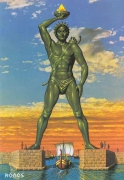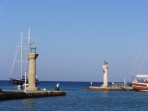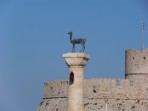Colossus of Rhodes (Kolos rhodes) - island of Rhodes

The Colossus of Rhodes, a huge bronze statue of the Greek god Helios, was one of the Seven Wonders of the Ancient World. However, to this day, it is not entirely clear if the Colossus of Rhodes actually existed, where exactly it stood on the island, or what it looked like. Most often, it is associated with the capital city of Rhodes.

After the great victory of the Rhodian people over the Syrian warriors in 305 BC, the inhabitants of the Greek island decided to built a statue in honour of the god Helios, the patron god of the island. They wanted to thank him for his help in repelling the invasion of the Syrian ruler Demetrius Poliorcetes. The money was raised by selling the captured war equipment and in 304 BC the construction of this monumental statue could begin. The creator of the colossus was Chares of Lindos, who worked with a group of builders and slaves for 12 years to make it. Only then he did unveil it to the inhabitants of the island. The statue's height and splendour were a source of admiration, but not everyone shared this enthusiasm, fearing that the statue's monumentality might anger the god Helios and cause him to sink the island of Rhodes into the sea.
Since neither the statue nor any of its parts have survived to this day, opinions vary as to what it actually looked like and where it stood. Most descriptions agree, that the Colossus of Rhodes was 33 m tall and stood on a massive marble base. It was a truly magnificent statue in its time and, at over 30 metres high, it could boast the title of the tallest statue of antiquity. The inhabitants of Rhodes were even called Colossians after the statue.
Inside, the statue was hollow and reinforced by an iron frame. It was gradually covered with bronze plates from the bottom up. Each slab was first hammered and shaped by craftsmen before being riveted to the iron structure and to the adjacent slabs. The calves, which held all the weight of the statue, had a solid core of heavy stone blocks. During the construction, the workers piled earth around the finished parts to reach the higher levels of the statue. After its completion, all the soil was removed and the statue was presented to the people.
Perhaps the biggest mystery is where the statue of the sun god was actually placed. According to some versions, it stood straddling above the Rhodian Mandraki harbor, each foot on a different pier, with ships passing under its feet. This reconstruction often appears in prints from the 16th to 19th centuries. However, this would not fit the proportions or stature of the statue; the feet would have to be far apart and the colossus would break at the hips. The prevailing view, therefore, is that the Colossus stood on a marble pedestal with its feet together, with only its right foot slightly bent. This was a typical posture of ancient statues. He was wearing a headdress, and the god's right hand was raised, holding a torch. The flaming torch is also said to have served as a unique beacon because it could be seen from a great distance. According to these theories, the Colossus stood on a hill near the capital city of Rhodes, with the most likely location being the courtyard of the Temple of Helios (where the Palace of the Grand Masters stands today), according to Rhodesian sources.
According to some scholars, the god was depicted completely naked. According to Wolfram Hoepfner, a German historian, Helios stood half-naked, with a cloak thrown over his naked body, but only partially covering him, the most delicate parts being visible. His right hand was raised and with his open palm he welcomed visitors arriving on the island of Rhodes.
However, the Colossus did not stand for long at the harbour of Rhodes. In 226 BC, a strong earthquake hit the area and the statue of Helios broke in the knees and collapsed to the ground. The inhabitants of Rhodes, probably because of superstition, did not dare to rebuild the statue or even to move its ruins. The shattered remains thus laid at their original place until 653, when the Arabs took control of Rhodes and stole the ruins. It is reported, that they sold them to a Syrian merchant who took them away and sold them as bronze scrap. This was then melted down and used for production of coins, weapons, etc.
Today, all that remained from the Colossus of Rhodes is an empty site and a lot of myths. Whether it stood at the Rhodian Mandraki Harbour or on the hill above the town or at the war port or anywhere else on Rhodes, it is the commercial port of Mandraki, that most tourists head for. On the piers, where the legs of the huge statue should be placed, two columns now stand - one with a hind and the other with a deer. These columns are one of the most famous symbols of the island of Rhodes.
Interesting:
- In ancient times, the word "colossus" referred to any statue. Thanks to the Colossus of Rhodes, this has changed and since its inception only statues of giant dimensions have been called such.
- The Colossus of Rhodes is considered to be one of the ancient Seven Wonders of the World, although it was no longer standing at the time this list was compiled.
- The Colossus had the shortest "life" of all the Seven Ancient Wonders, standing in place for only 66 years.
- In its time, the Colossus was such a prominent feature of the island, that the medieval Greeks and Franks called the islanders Colossians. Rhodes in general stood out for its giant sculptures and had a world-famous school of art.
- In order to cover the existing appearance of the growing Colossus, Chares of Lindus built it by surrounding it with tons of sand and gravel.
- It is also said that when the sculptor Chares of Lindos was shown a small blemish on the bronze mantle of the statue after its completion, he committed suicide.
- In 2016, a team of young professionals from different European countries, led by the Rhodian architect Ari A. Palla came with the idea of reviving one of the biggest symbols of the island of Rhodes and rebuilding the Colossus of Rhodes. The plans of this team are very ambitious, as it is not to be a mere copy of the original, but a much more gigantic structure that will captivate people just like the original Colossus in antiquity, while at the same time the new Colossus of Rhodes is also to be modern and multifunctional.
More touristic destinations of Rhodes
Most favourite sights of Rhodes: Acropolis of Lindos, Acropolis of Rhodes, Monolithos Castle, Tsambika Monastery, Kolossos of Rhodes, Palace of the Grand Masters - Rhodes Town
Resorts, beaches, sights or trips - clearly listed on the map of Rhodes.
Did you visit this place and do you have some additional informations, interessting observation or photos?





